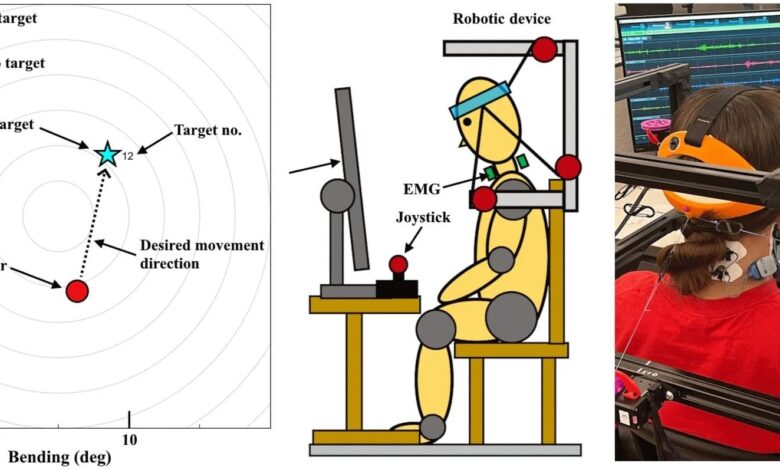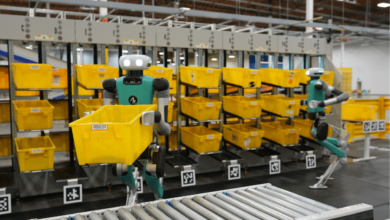Cable-Driven Robotic Platform for Natural Head-Neck Movements

In a recently published paper in the journal Scientific Reports, researchers from the USA introduced a novel cable-driven robotic platform that enables six-degrees-of-freedom (DoF) natural head-neck movements. Their device could be utilized for various applications such as rehabilitation, sensory integration, and pain relief.
Background
The head-neck system offers the head 6-DoF mobility relative to the trunk. Despite this remarkable flexibility, neurological disorders can severely impact these movements, leading to symptoms like poor motor control, dropped head posture, and reduced overall quality of life. Present treatments, often relying on static neck collars or rigid exoskeletons, fall short, imposing restrictions rather than aiding natural head-neck movements. Therefore, there is a pressing demand for innovative devices capable of enabling and enhancing these movements, thereby addressing the limitations of existing treatments.
About the Research
In this study, the authors designed and validated a cable-driven robotic platform capable of measuring and controlling 6-DoF head-neck movements without imposing rigid kinematic constraints. The platform consists of seven cables connected to a headpiece rigidly fixed to the user’s head, with servo motors mounted on a chair-mounted frame actuating the cables. Using a forward kinematics algorithm, the device calculates the head orientation based on cable lengths and employs a tension distribution algorithm to apply a desired wrench (force and moment) on the head, either through user input or a predefined control law.
The developed robot was optimized to ensure high transmission efficiency of cable tensions to the resultant moment on the head across the natural range of head-neck motion. Calibration procedures were conducted to determine the user’s neutral position and ensure accurate cable length measurements. Benchtop tests were performed to assess the platform’s forward kinematics and wrench output capabilities, demonstrating its capability for accurately measuring head position and orientation while effectively applying the desired wrench on the head with good accuracy and repeatability.
The researchers conducted a human experiment to showcase the device’s potential for rehabilitation. They recruited 12 healthy participants and tasked them with performing a target-reaching activity involving head rotations while utilizing the device. Additionally, they implemented three control modes: a resistive force field mode, a torque control mode, and an orientation control mode. Head kinematics and the activation of four neck muscles were measured using surface electromyography (EMG).
Research Findings
The outcomes indicated that the resistive force field mode increased the activation of the targeted neck muscles by an average of 19%, whereas the assistive control modes reduced the activation by an average of 28-43%. Additionally, the results revealed that the orientation control mode enhanced task performance (with a lower average time to reach the target) compared to the torque control mode. However, despite this improvement, most participants expressed a preference for the torque control mode due to its smoothness and ease of use. Moreover, the muscle activation patterns aligned consistently with the direction of head movement needed for the task.
Applications
The proposed device has various implications that require 6-DoF head–neck movements and force/moment application on the head. For example, it can treat patients with head-neck impairments, such as amyotrophic lateral sclerosis (ALS) or cerebral palsy (CP). Additionally, it can be utilized for pain relief and spinal alignment by applying traction forces on the head.
In sports training, athletes can utilize the new device to enhance reflexes, coordination, and neck strength, particularly in disciplines such as boxing or martial arts. Integration with virtual reality (VR) systems enhances gaming experiences by accurately tracking head movements and providing realistic force feedback.
In occupational therapy, individuals recovering from neck injuries or surgeries can incorporate the device into their rehabilitation programs to restore mobility and strength in neck muscles. Furthermore, it can be adapted into assistive devices for individuals with disabilities, enabling control of various electronic interfaces or devices through head movements.
Researchers in biomechanics, ergonomics, and neurology can leverage the device to study head and neck movements across different contexts, advancing the understanding of human physiology and facilitating the design of safer work environments. Lastly, in entertainment and media production, the device’s capabilities can be used to capture lifelike head movements for creating realistic characters or special effects sequences.
Conclusion
In summary, the newly developed robotic platform proved highly effective in facilitating 6 DoF natural head-neck movements and applying force/moment on the head. Through optimization, validation, and human testing, the authors showcased its potential for rehabilitation and beyond.
The device exhibited commendable performance in measuring and controlling head-neck movements and regulating neck muscle activation. Its adaptability showed its ability to implement various control modes and adjust parameters according to user preference and capability.
Moving forward, the researchers acknowledged areas for improvement, including enhancing twist axis performance, reducing device size and weight, and exploring new design and control approaches for diverse applications.
Journal Reference
Bales, I., Zhang, H. A six degrees-of-freedom cable-driven robotic platform for head–neck movement. Sci Rep 14, 8750 (2024). https://doi.org/10.1038/s41598-024-59349-0, https://www.nature.com/articles/s41598-024-59349-0.



